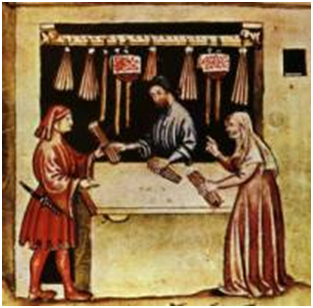A fine profession for both gentlemen and ladies during the medieval period (as well as before and after it) was that of the chandler. This title could refer to either the maker of candles and soaps, or the position in a noble household that is responsible for these items (including wax). The profession rose to prominence throughout Europe as candles became more widely used in homes and especially in church services.
The earliest candles were made from tallow. Tallow is basically the rendered fat of animals (sheep and cows usually). Unfortunately, it tends to emit an acidic odor, even when extinguished. The quality of light was also lesser, providing a yellowish glow. Tallow candles also tend to burn unevenly, making them inefficient. "Rushlights" were made simply by dipping the pith of rushes (plants, like the cattail) into the fat accumulated in the kitchen as a result of cooking. Early candles also had wicks made from rushes, but the tallow was either poured over the wicks and formed by hand, or dipped in batches. When dipping candles, they were first dipped three times, then allowed to harden, before then being dipped to the preferred thickness. These were sold in bundles, by weight.

Materials utilized by Chandlers quite naturally evolved over time, most notably with the use of beeswax in their candles. this material burns cleaner and produces a whiter light than tallow. Beeswax is quite literally that, the wax produced by worker bees. Being much harder to come by and usable for a variety of purposes, it was much more expensive. These candles were naturally used mostly by the elite and in religious ceremonies. Scents were also added at times to the mix, for obvious reasons. Canon law declared that candles used in European cathedrals must be composed of at least sixty percent beeswax. The rate of burning in these candles was eventually formalized enough to use the candles to tell time (burning so much per hour). This evolved odd uses like the courting candle (see pic, right), which limited a gentleman's time to visit his beloved (17thC).
Soap-making became part of the chandler's trade simply because of the common use of tallow. Lye, oils and ash were also used in the mix to create the soap. Contrary to popular belief, bathing was quite common throughout Europe up until the time of the Black Death, when folks got some interesting ideas about its pathways of transmission. Public baths, also known as "stews," were used by the common people (though later the term was appropriated to refer to a neighborhood in London, famous for its brothels), though not as regularly as the gentry. Tallow soap continued to be used by the lower classes long after better soaps (less likely to go rancid, or burn) were devised.
Chandlers, like many medieval trades, were highly regulated. They were divide into two separate guilds: those who made tallow candles and those who made beeswax candles. Due to odoriferous nature of their product, candle making was often restricted to certain areas of town, often near the butchers and tanners. In some cities it was banned altogether.
Eventually, chandlers moved on to include more general use goods amongst their wares, such as: sauces, vinegar and cheeses. Tallow candles were used as street lighting in London starting in 1415, lending a warm glow to the goings on long before gaslight. The whiter light of beeswax brighten some churches on Candlemas (February 2nd) even today. The efforts of the chandler added illumination (and odors) to households across medieval Europe.

http://suite101.com/a/the-occupation-of-chandler-in-the-middle-ages-a278193
http://www.essortment.com/candle-making-history-51363.html
http://www.timelesswroughtiron.com/history-of-courting-candles-s/175.htm
http://www.livinghistory.co.uk/homepages/historicalballs/History%20of%20soapmaking.htm
http://en.wikipedia.org/wiki/History_of_candle_making
No comments:
Post a Comment